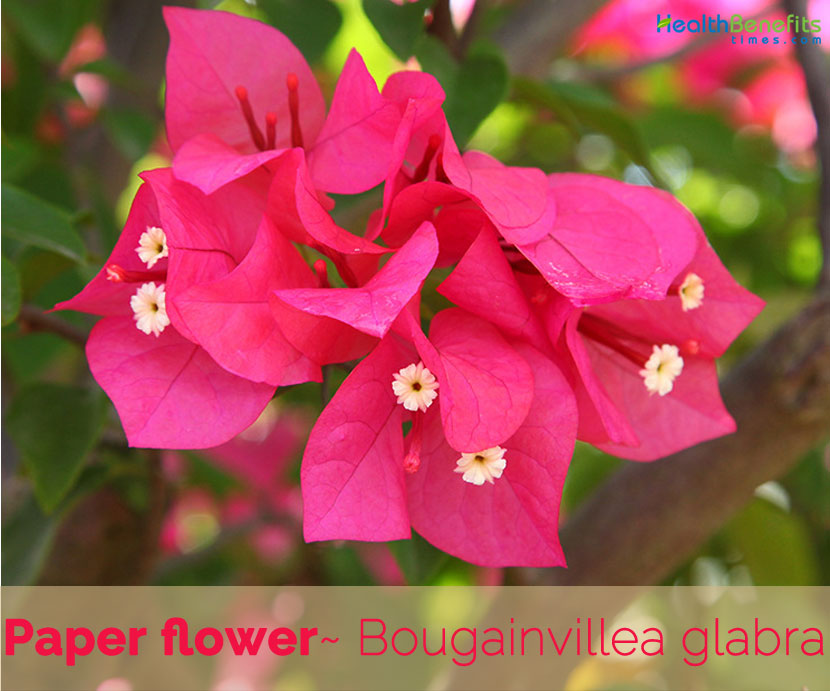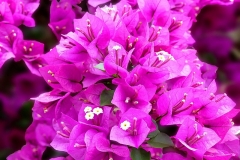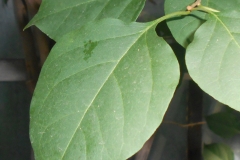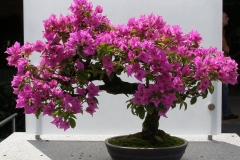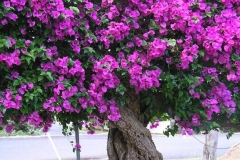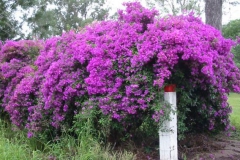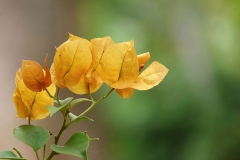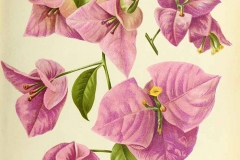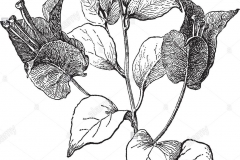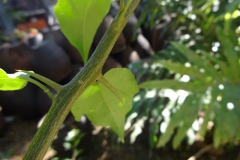The specific epithet name glabra means smooth, no hair. The genus was named after de Bougainville, 1729-1811, French navigator. It was originally spelled Buginvillea. With its sharp thick thorns it is avoided by cattle, goats, monkeys and even birds. It loves open sunshine and the colors of some varieties grow brighter and more attractive in hot dry climate. A postal stamp was issued by the Indian Postal Department to memorialize this flower. Paper Flower, is one of the traditional medicinal plants with potential antifertility activity. The aqueous extract and decoction of this plant have been used as fertility control among the tribal people in many countries. Furthermore, it has been shown to possess anticancer, anti-diabetic, anti-hepatotoxic, anti-inflammatory, anti-hyperlipidemic, antimicrobial, antioxidant, and antiulcer properties.
Paper Flower Plant Facts
| Paper Flower Quick Facts | |
|---|---|
| Name: | Paper Flower |
| Scientific Name: | Bougainvillea glabra |
| Origin | South America from Brazil to Peru and to Southern Argentina |
| Colors | Brown |
| Shapes | Small elongated five-lobed achene fruit about 1–2 cm long |
| Health benefits | Relieve fever, Treat cough, Relieve sore throat, Anti-diabetic, Treat diarrhea, Enhance respiratory, Cure stomachache, Body detoxifier, Ease joints pain, Regulates Blood Pressure, Prevent Inflammation of the Stomach, Antiseptic property, Maintaining the Balance of Cholesterol |
| Name | Paper Flower |
|---|---|
| Scientific Name | Bougainvillea glabra |
| Native | South America from Brazil to Peru and to Southern Argentina |
| Common Names | Bougainvillea, Glory of the Garden, Lesser Bougainvillea, Paper Flower |
| Name in Other Languages | Albanian: Bugenvilé Arabic: bwghnfylyt jurada (بوغنفيلية جرداء) Assamese: Kagaj-phul, Bagan-bilas Azerbaijani: Çılpaq buqenvilleya Bengali: Baganbilas Brazil : Buganvilea, Cansarina, Ceboleiro, Flor-De- Papel, Juvu, Pataguinha, Primavera, Rios Do Prado, Roseiro, Roseta, Snata-Rira, Sempre-Lustrosa, Tres-Marias Burmese : Sekku-Pan Catalan : Buguenvíl.Lea, Buguenvíl.Lea Comuna Chinese : Guang Yi Zi Hua (光叶子花), mao bao jin, jiu chong ge, san jiao hua, ye zi hua Czech: Bugenvilea lysá English: Paperflower, lesser bougainvillea Finnish: Kaljuihmeköynnös French : Bougainvillée, Bougainvillier, bougainvillée glabre German : Bougainvillie, Drillingsblume, Kahle Drillingsblume, Bougainvillea Hindi: Booganbel (बूगनबेल) Hungarian: Kopasz murvafürt Indonesia : Buganvil, kembang kertas, bunga kertas Italian : Buganvillea Japanese: Felila Konkani: Bouganvila (बुगनविला), bougainvillea Malay: Buganvil, buginvila, pokok bunga kertas Malayalam: Bēāgainvilla glābra (ബോഗൈൻവില്ല ഗ്ലാബ്ര) Malaysia : Bunga Kertas, Buganvil, Buginvila Manipuri: Cherei (চেরৈ), ꯆꯦꯔꯩ Marathi: Booganvel (बूगनवेल) Mexico : Bugambilia, Shpupu-Kutshanat Nepali: Kaagate phool (कागते फूल) Philippines : Bogambilya, Bongabilya Polish: Bugenwilla gładka Portuguese: Juvú, Três-marias, primavera, buganvilia, ceboleiro, pataguinha, roseiro, roseta, santa-rita, sempre-lustrosa, ceboleiro-de-mata Russian: Bugenvilliya golaya (бугенвиллия голая) Spanish : Bogambilia, Boganvilla, Bugambilia Morada, Bugambilia Roja, Buganvilla, Buganvillea Lisa, Buganvilia, Bugenvil, Dania, Enredadera De Papel, Flor De Papel, Flor De Varano, Santa Rita, Trinitaria, Veranilla, bougainvillea, trinitaria roja Swedish : Blank Trillingblomma Tagalog: Bugambilia, bogambilya Telegu: Kagithala Puvvu (కాగితాల పువ్వు) Thai : Fueangfa, fuang fah Turkish: Gelinduvağı Vietnamese : Hoa Giấy Nhẵn, hoa giay, bong giay |
| Plant Growth Habit | Vigorous, evergreen, climbing, rambling shrub or woody liane |
| Growing Climates | Atlantic rainforest, semi deciduous forests, in both dense primary forest, sandy desert soils, slopes, mesas and disturbed rocky soil |
| Soil | Perform best in a well-drained, fertile, light soil in a sunny position. Although drought tolerant, they need plenty of moisture during the flowering season |
| Plant Size | Usually grows 10–12 ft (3.0–3.7 m) tall, occasionally up to 30 ft (9 m) |
| Bark | Pale and corky |
| Stem | Woody perennial vine, with multi trunked and large clumping stems which spread up to 2–4 m |
| Leaf | Alternate, finely pubescent abaxially, glabrous adaxially, ovate, ovate–lanceolate to elliptical, 5–13 cm long and 3–6 cm wide |
| Flower | Insignificant, bisexual, occurs in 3-flowered cymose units subtended by showy colorful chartaceous, foliaceous bracts |
| Fruit Shape & Size | Small elongated five-lobed achene fruit is 1–2 cm long |
| Fruit Color | Brown |
| Lifespan | 25-50 years |
| Propagation | By cuttings |
| Pest | Mites, Thrips, Scales, Aphids |
| Disease | Fungal and bacterial leaf spot disease |
| Health Benefits |
|
| Culinary Uses |
|
| Precautions |
|
Plant Description
Paper flower is a vigorous, evergreen, climbing, rambling shrub or woody liane that normally grows about 10–12 ft. (3.0–3.7 m) tall, occasionally up to 30 ft. (9 m) with thick, glabrous to sparsely pubescent stem and pendent branches with curved axillary spines, 5–15 mm long. The plant is found growing in Atlantic rainforest, semi deciduous forests, in dense primary forest, sandy desert soils, slopes, mesas and disturbed rocky soil. Normally the plants perform best in a well-drained, fertile, light soil in a sunny position. Although drought tolerant, they need plenty of moisture during the flowering season. It is a woody perennial vine, with multi trunked and large clumping stems which spread up to 2–4 m. The clumping stem uses thinning branches attached the curved thorns. The color of growing stems is from green to dark green. Bark is pale and corky.
Leaves
Leaves are alternate, finely pubescent abaxially, glabrous adaxially, ovate, ovate–lanceolate to elliptical, 5–13 cm long and 3–6 cm wide on 1 cm long petioles. Leaves are deep green, leathery in texture, and hairy underneath.
| Leaf Arrangement | Alternate |
| Leaf Venation | Pinnate |
| Leaf Persistence | Evergreen |
| Leaf Type | Simple |
| Leaf Blade | Less than 5 |
| Leaf Shape | Lanceolate |
| Leaf Margins | Undulate |
| Leaf Textures | Smooth |
| Leaf Scent | No Fragrance |
| Color(growing season) | Green |
| Color(changing season) | Green |
Flower
Flowers are insignificant, bisexual, occurs in 3-flowered cymose units subtended by impressive colorful chartaceous, foliaceous bracts. Bracts are ovate to deltoid– ovate, 2–5 cm long, 1.54 cm wide, with acuminate or acutely pointed tips and cordate bases, usually purple or magenta, but also red, pink, orange or white. Flowers with 1–2.5 cm long perianth tube which is dilated basally, distinctly angled, sparsely pubescent, ribbed, apex 5-lobed white to creamy white, curved away from pedicel. From the base of the tube arises a single carpel, and encircling the ovary is a cup shaped nectar, from its rim arises 6–8 stamens. Tiny white flowers usually appear in clusters surrounded by colorful papery bracts, hence the name paper flower. Fertile flowers are followed by small elongated five-lobed achene fruit about 1–2 cm long. It is rather one- seeded, inconspicuous, not showy, and has a dry, hard fruit cover
| Flower Showiness | True |
| Flower Size Range | 0 – 1.5 |
| Flower Type | Solitary |
| Flower Sexuality | Monoecious (Bisexual) |
| Flower Scent | No Fragrance |
| Flower Color | Yellow, Orange, Red, Purple, Variegated, White |
| Seasons | Spring, Summer |
| Fruit Type | Achene/Akene |
| Fruit Showiness | False |
| Fruit Size Range | 0 – 1.5 |
| Fruit Colors | Brown |
| Seasons | Spring, Summer |
History
Bougainvillea species including B. glabra are native to South America from Brazil to Peru and to Southern Argentina (Chubut Province). It has been introduced pantropically and is a popular ornamental plant in the warm areas of Asia, Southeast Asia, Australia, the Pacific Islands, and the Mediterranean region, the Caribbean, Mexico, South Africa and the United States in Arizona, California, Florida, Hawaii and Southern Texas.
Health Benefits of Paper Flower
Among the health benefits of Paper flower, the most acknowledged benefit is the ability of the flowers in dealing with respiratory problems. It includes the ability of Paper flower in healing cough and relieving sore throat. Besides, there are many more health benefits of the flowers. The other health benefits are listed as follows:
1. Relieve fever
Drinking Paper flower infusion or tea is known to be effective to reduce fever. It is possible since it possess the antipyretic properties. The antipyretic properties enable Paper flower to quickly and naturally reduce fever. Thus, it is good to be applied for children, as it has minimal side effect.
2. Treat cough
Just like the health Benefits of Goldenseal and Echinacea, Paper flower are also suggested for cough. It is possible since Paper flower possess expectorant property which supports the discharge of mucus from respiratory tract. The excretion of mucus is able to boost the cough recovery.
3. Relieve sore throat
Sore throat might be caused by allergy or infection. In this case, Paper flower are able to offer you the solution. The antiseptic property of Paper flower makes it possible for the Paper flower tea to instantly reduce inflammation and relieve the sore part.
4. Anti-diabetic
The concussion of the research showed the data suggest that A. indica chloroform extract and B. spectabilis aqueous, methanolic extracts exhibit islet regeneration/protection properties and therefore have beneficial effects in diabetes mellitus that holds the hope of new generation of anti-diabetic drugs.
5. Treat diarrhea
Drinking Paper flower infusion for diarrhea is able to boost the recovery process. It is strongly connected to the ability of Paper flower to flush out toxins. As we know, diarrhea appears as the reaction to the toxins or the unwanted material within the digestive tract.
6. Enhance respiratory
Consuming Paper flower infusion will help you to enhance the respiratory system. It is possible since Paper flower has a good effect for lungs. It enables lung to optimally perform its function in giving off the oxygen needed by the body.
7. Cure stomachache
Warm tea is always a good idea for stomach ache. Just like the Health Benefits of Hyssop Tea, taking warm Paper flower tea is also able to cure stomachache, especially due to the high acidity. This evergreen thorny flower is amazingly to reduce the high acidity of stomach.
8. Body detoxifier
Talking about natural body detoxifier, you might never miss the health Benefits of Drinking Hot Water with Lemon. However, you should know that the purple Paper flower also possess the ability to clean out the body. Regular consumption of it will help your body to flush toxins, and the other unwanted material we get from our unhealthy diet and the exposure to pollution.
9. Ease joints pain
The ability of Paper flower in performing as anti-inflammatory agent help us to deal with inflammation problem. The most common problem is the joint pain in aging people due to the inflamed joints. Therefore, Paper flower can be used as natural remedy for joints pain. It efficiently eases the pain by reducing the inflammation.
10. Regulates Blood Pressure
In Mexico Paper flower can be used as a natural drink to tackle high blood pressure and regulate blood pressure. The compound resulting from the benefits of dried flowers can delay buildup of plaque in blood vessels. It’s what makes the blood pressure becomes more stable with the treatment of Paper flower.
11. Prevent Inflammation of the Stomach
Inflammation of the stomach may cause several disorders one of which is the inflammation of the more severe stages. To overcome this leaf extract of Paper flower can be used as a natural remedy to cure the inflammation in the intestine. Chemical compounds in the leaves can cause protective effects and soothing to the intestine. This step is very important to maintain the health of the stomach and intestines.
12. Antiseptic property
When common people praise Paper flower for its beautiful colors, the medical personnel praise Paper flower for its antiseptic property. It enables us to use Paper flower infusion as cleanser. We can use it for facial cleanser which deep clean skin and prevent acne. Or else, we can also use the infusion to keep vaginal health.
13. Maintaining the Balance of Cholesterol
Amount of LDL and HDL cholesterol in the body is very dependent from the type of food consumed. Too much bad cholesterol can increases the risk of disease high blood pressure, diabetes, heart attack and stroke.
Consumption of tea from flowers of Paper flower plant has done since ancient times in Mexico. Extracts from the leaves of Paper flower helps to maintain balance of cholesterol and blood pressure.
Traditional uses and benefits of Paper flower
- Bougainvillea glabra (mainly leaves) have been used by traditional practitioners of Mandsaur for variety of disorders like diarrhea, excessive stomach acidity, cough and sore throat in India.
- Decoction of dried flowers is used for blood vessels and Leucorrhoea.
- Decoction of the stem is used for hepatitis.
- Plant has been reported to be used by traditional medicine practitioners for the treatment of diabetes mellitus.
- Leaves are considered to have anti-inflammatory activity.
- The leaves are anthelmintic and antibacterial.
- It is most commonly used as a tea for cough, sore throat, flu, fever, diarrhea, and diabetes.
- It is also used for hepatitis and liver problems, asthma, bronchitis, to reduce stomach acidity, dissolve blood-clots, to regulate menstruation and stop leucorrhea, and for anemia associated with gastrointestinal bleeding and epigastric pain.
- An infusion of the flowers of B. glabra used as treatment for low blood pressure in Panama.
- Nupe people of Niger use a crude extract of leaves for diabetes.
Other facts
- B. glabra is popularly cultivated as ornamental landscape features, garden, potted and indoor plants and can also be used for bonsai.
- Juice obtained from flowers of Bougainvillea glabra could be used to differentiate solutions in pH range of 7–10 because it showed different colors at each pH from 7 to 10.
- It afforded similar results as obtained by phenolphthalein and could be used as an acid-base indicator.
- The plant is traditionally grown in living fences in the northwestern Himalayas, where it helps to exclude livestock and other animals.
- Wood is light in weight, soft, porous and with a very low durability and is only used for rural constructions and for fuel.
- Postal stamp was issued by the Indian Postal Department to commemorate this flower.
- Best blooming occurs when the night length and day length are almost equal.
Problems with Paper flower
It is not common for Bougainvillea glabra to be affected by pests and diseases, but some problems may appear due to unbalanced feed and poor conditions.
Overfeeding will produce masses of foliage but very little in the way of colorful bracts.
The old established method of forcing flowers is to withhold water to a point of causing severe stress to the plant.
Caterpillars, aphids and scale may infest Bougainvillea glabra plants.
Treatment: Use an appropriate pesticide to eliminate these pests.
Bougainvillea glabra may also develop chlorosis as response to mineral deficiencies:
- Nitrogen deficiency: Older leaves turn a pale green and the veins are usually a reddish color. New growth will be stunted.
- Phosphorus deficiency: The veins will turn red to purple and the plant as a whole will look purplish.
- Potassium deficiency: Causes the edges of older the leaves to be a purple color and the leaf tips will be a brownish color.
- Magnesium deficiency: First appears on older leaves where they turn a spotted yellow or tan color.
- Zinc deficiency: (rare) Will look almost like magnesium but here the leaf will be twisted.
- Iron deficiency: Young growth is stunted and pale, but the veins on the leaf remain green.
- Calcium deficiency: Dead areas appear in young growth and the tips soon die.
Treatment: Recommended remedy for any of the deficiencies above is the application of a complete micronutrient blend.
Root rot: Root rot will appear when plants are over-watered or are subjected to water logged conditions.
Treatment: These situations are easier to be prevented. Apply broad spectrum fungicides during transplanting or planting in landscape.
Fungal and Bacterial Leaf Spot: Fungal and Bacterial Leaf Spot (Pseudomonas and ropogonis) infections appear as dark necrotic spots on leaves and bracts and puckered and distorted growth. Defoliation will occur when leaf spotting, blighting or marginal necrosis becomes severe. Care must be taken that fungus does not invade other trees and shrubs around.
Treatment: Maintaining dry foliage is the primary control measure. Remove and dispose infected leaves and/or plants from the growing area. Apply fungicides as preventive measure.
References:
https://www.itis.gov/servlet/SingleRpt/SingleRpt?search_topic=TSN&search_value=19683#null
https://npgsweb.ars-grin.gov/gringlobal/taxonomydetail.aspx?id=7511
https://plants.usda.gov/core/profile?symbol=BOGL4
https://bie.ala.org.au/species/http://id.biodiversity.org.au/node/apni/2915828
https://wikivisually.com/wiki/Bougainvillea_glabra
http://www.theplantlist.org/tpl1.1/record/kew-2680754
http://www.maltawildplants.com/NYCT/Bougainvillea_glabra.php
https://indiabiodiversity.org/species/show/266319
https://en.wikipedia.org/wiki/Bougainvillea_glabra
https://gd.eppo.int/taxon/BOUGL
https://www.ncbi.nlm.nih.gov/pmc/articles/PMC5414450/
https://pdfs.semanticscholar.org/6343/fbe77a575f5c6892cddaf25fff8ac6065b39.pdf
http://tropical.theferns.info/viewtropical.php?id=Bougainvillea+glabra
http://www.flowersofindia.net/catalog/slides/Bougainvillea.html
https://link.springer.com/chapter/10.1007/978-94-017-8748-2_33
https://www.cabi.org/isc/datasheet/109866
http://www.plantsrescue.com/tag/bougainvillea-glabra/
https://landscapeplants.aub.edu.lb/Plants/GetPDF/38f28348-43e0-4963-9270-a0d4743b7336


